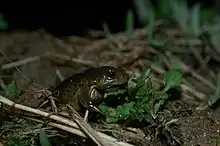| Boreal digging frog | |
|---|---|
 | |
| Scientific classification | |
| Domain: | Eukaryota |
| Kingdom: | Animalia |
| Phylum: | Chordata |
| Class: | Amphibia |
| Order: | Anura |
| Family: | Microhylidae |
| Genus: | Kaloula |
| Species: | K. borealis |
| Binomial name | |
| Kaloula borealis (Barbour, 1908) | |
The boreal digging frog (Kaloula borealis) is a species of microhylid, or "narrow-mouthed," frog found in Northeast Asia. Its range covers much of central and northeastern China, the Korean Peninsula, and Jeju Island.[2] Adult boreal digging frogs are roughly 4.5 cm in length, round in shape with toad-like speckled skin.[3] Tadpoles are up to 35 mm (1.4 in) in length.[4]
The boreal digging frog is common across much of its range,[1] but is listed as an "Endangered category II species" in South Korea.[3][5] It inhabits cultivated fields, including rice paddies, and is often found in close proximity to humanity, at altitudes of 10 to 900 m.[1]
Boreal digging frogs breed during the annual rainy season, around June and July. After the rainy season is over they dig burrows underground, emerging only at night to feed. The eggs are laid in batches of 15–20 in monsoonal pools, with the tadpoles maturing within 30 days, much faster than most other frogs in this area.[3]
References
- 1 2 3 IUCN SSC Amphibian Specialist Group (2020). "Kaloula borealis". IUCN Red List of Threatened Species. 2020: e.T57849A63887081. doi:10.2305/IUCN.UK.2020-1.RLTS.T57849A63887081.en. Retrieved 20 November 2021.
- ↑ Frost, Darrel R. (2014). "Kaloula borealis (Barbour, 1908)". Amphibian Species of the World: an Online Reference. Version 6.0. American Museum of Natural History. Retrieved 22 September 2014.
- ↑ Fei, L. (1999). Atlas of Amphibians of China (in Chinese). Zhengzhou: Henan Press of Science and Technology. pp. 300–302. ISBN 7-5349-1835-9.
- ↑ Park, Daesik; Kaplan, Robert H. (2013). "Korea regional update". FrogLog. 21 (4): 34–35. Archived from the original on 2013-10-29. Retrieved 2013-10-28.
